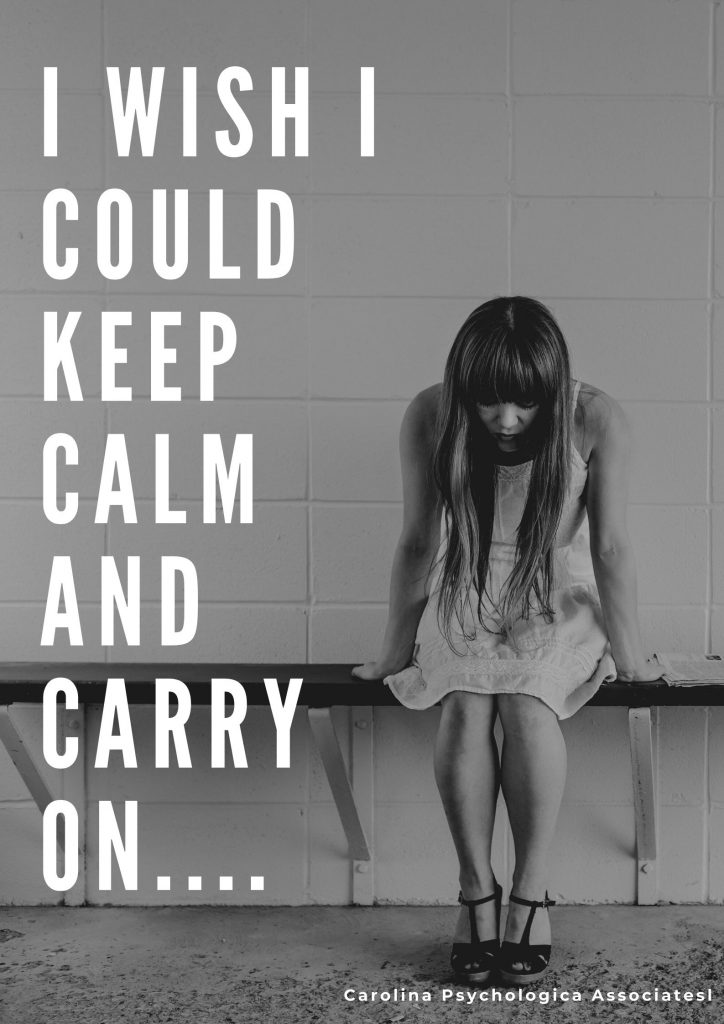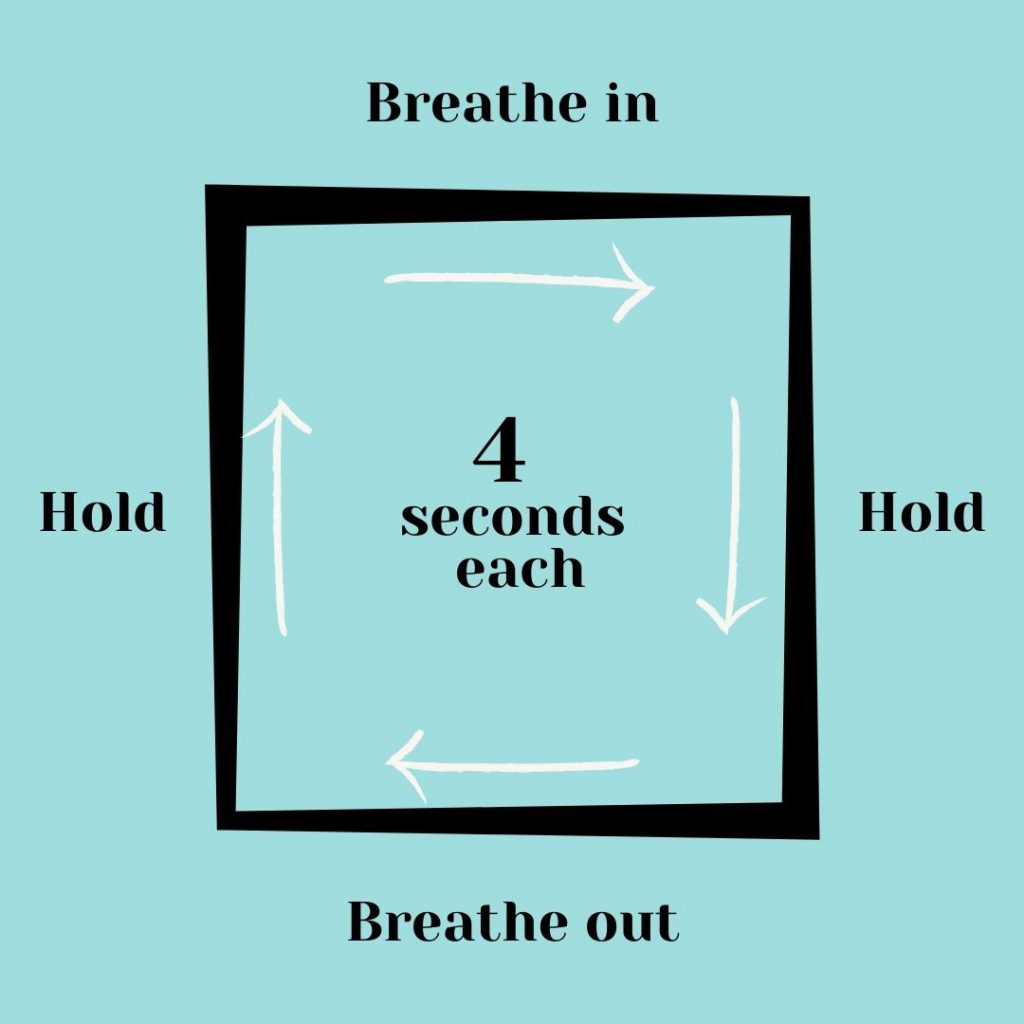Do you wish you could “keep calm and carry on?”
 Many people say, “keep calm and carry on,” but that can be incredibly difficult for someone experiencing anxiety. Anxiety looks and feels different for each person because our bodies respond differently to the things surrounding us. Do you think you experience anxiety, but you’re just not sure? Or maybe you’ve struggled with it for as long as you can remember?
Many people say, “keep calm and carry on,” but that can be incredibly difficult for someone experiencing anxiety. Anxiety looks and feels different for each person because our bodies respond differently to the things surrounding us. Do you think you experience anxiety, but you’re just not sure? Or maybe you’ve struggled with it for as long as you can remember?
Oftentimes, anxiety can look like an elevated heart rate, sweaty palms, flushed skin, difficulty falling asleep, and tense muscles.
Classic examples of when you might notice higher levels of anxiety are while public speaking, going on a first date, or walking into an event where you only know a few people. These situations are understandable for someone to experience anxiety, right?
But anxiety doesn’t always happen in one of those settings. Sometimes it feels random, like while you’re driving in the car, sitting in class, at work, or even while lying in bed trying to go to sleep. Often, anxiety catches us completely off guard, as these feelings seem to come out of nowhere!
What do you do when this happens?
Anxiety is a way for our bodies to be prepared to act, whether that be freeze and hide or run away as fast as possible. However, when we’re simply trying to fall asleep neither of these options are realistic or helpful.
There are a vast number of coping skills that can help reduce anxiety. The main priority in all of them is to convey to our brains and bodies that we indeed are okay and are not in harm’s way.
Below are a few of the many options that can help reduce anxiety:
Breathing
You might be asking, “I am currently breathing…to stay alive….how in the world can this help me with anxiety??”
Well, believe it or not breathing can greatly reduce anxiety and has been shown to do this time and time again through research. Paying attention to your breath brings you into the present moment and slowing down your breath can even slow your heart rate down!
Box breathing is a simple breathing technique that you can do anywhere!
Wherever you are, spend a moment focusing on your breath. Then, whenever you are ready, slowly inhale to the count of four. Hold your breath for four seconds. Then, slowly exhale to the count of four. And finally, hold your breath again for a count of four before starting again. Repeat this a couple of times.
Feel free to do this exercise multiple times a day!
Meditation
No, you don’t have to be a yoga extraordinaire to be able to practice mindfulness! For many people, mindfulness can seem very daunting and intimidating at first. Being alone with your thoughts might even seem terrifying. But, keep in mind that mindfulness is a skill, it’s something that needs to be practiced regularly to gain experience. However, you don’t even need to be an expert to at mindfulness to gain the benefits!
We tend to walk through the day focusing on what has already happened or preparing for what is going to happen in the future. Mindfulness simply brings your mind to the present moment, away from the past or the future. There are a couple ways to do this:
- Focus Meditations: Find an object where you are and spend some time focusing on that object. What color is it? What does it feel like? Smell like? Pay attention to the lines of this object. Spend time memorizing that object and every single detail about it.
- Mindful Walking: During a walk, notice all the things around you. Are there leaves on the trees? Is the wind blowing? Are there any noises around you? What does it sound like when your feet hit the ground? How does the sun feel on your skin? Take note throughout your walk of all your surroundings.
You might find these difficult at first. Your mind might start to wander, causing your thoughts to go off on tangents. Remember that mindfulness takes practice and patience. When you find your mind wandering, simply bring your thoughts back to what you were focusing on previously. Be kind to yourself, this is a skill and will take time!
Grounding
When anxiety takes over it’s easy to get lost in your thoughts. You might even feel like you’re starting to float away. Grounding can counteract that feeling and bring you back to the present moment, again.
A very simple way to ground yourself is to take your shoes off. Take a minute to feel the ground underneath you. It might even help to go outside and stand barefoot on the grass. I know this seems like such a simple thing, but it can really help bring your thoughts back to the present moment by including your sense of touch.
Doing a daily body scan is another great grounding exercise. Spend some time, wherever you are, focusing on your body. What feels tense? What is sore or maybe even hurts? Can you feel your heartbeat? Are your legs crossed or are both feet on the floor? Take enough time that you can spend an equal amount of time on each part of your body: head, neck, shoulders, arms, chest, stomach, legs, ankles, and feet.
Remember, there is no quick fix. But the first step in alleviating anxiety is recognizing and acknowledging it. After you recognize your anxiety increasing, practice one of these exercises. Your anxiety won’t disappear completely, but you might be more relaxed and even find that your concentration and attention improve! Living with anxiety can be difficult, but hopefully these exercises will give you a few tools to help cope with it.

